In 2021, residents along the Gujjar nullah in Karachi saw their houses unceremoniously destroyed as “encroachments” to the city’s drainage. Now, a grassroots movement is fighting for climate solutions that will help everyone in the city by the sea – not just the wealthy.
When I met Erum Yasmeen, 44, this summer, we stood on a mound of rubble overlooking a waterway choked with garbage, debris, and broken water-pipes. Gesturing towards the stream—a hyperbole, since the water, the color of soot, was untraceable under mounds of plastic and toxic waste from broken sewerage lines—she told me this was where her home once lay: the home built by her father-in-law back in the 1950s, back when Karachi was the capital of a new country, emanating promise. Now, the capital is 1200 kilometers away and Karachi, home to 20 million people, has found itself in the midst of a raging climate catastrophe.
On August 27, 2020, nine inches of rainfall lashed Karachi in twelve hours and turned streets into rivers. Containers—placed on thoroughfares as barricades for religious processions that were supposed to take place that weekend—turned into uncontrollable mankillers, floating on streets that had turned into canals, ramming into cars and pedestrians wading through waist-deep rainwater.
Karachi is among the world’s least livable cities, ranking 136th out of 140 on an index produced by The Economist’. Large housing projects have cut through mangrove forests and the city’s natural drains and waterways are choked with plastic waste. Unfortunately, warning signs of the impending climate crisis have been compounded by local authorities’ reluctance to address the matter seriously, and mitigate its harmful effects by building climate-resistant homes and buildings, and ensuring the upkeep and maintenance of the city’s storm-water drains.
And when city authorities do take action, scores are left homeless. Since February 2021, at least 12,000 houses, according to local activists, have been razed down along the Gujjar nullah—one of the many waterways crisscrossing the city on their way towards the Arabian sea—including Yasmeen’s home in Kausar Niazi Colony. The waterway itself is nearly 28 kilometers long, making it one of the city’s largest—its northern extremity falls in North Karachi Township, and it travels southwards, cutting through several neighborhoods until it sinks into the Lyari river just off Liaquatabad.
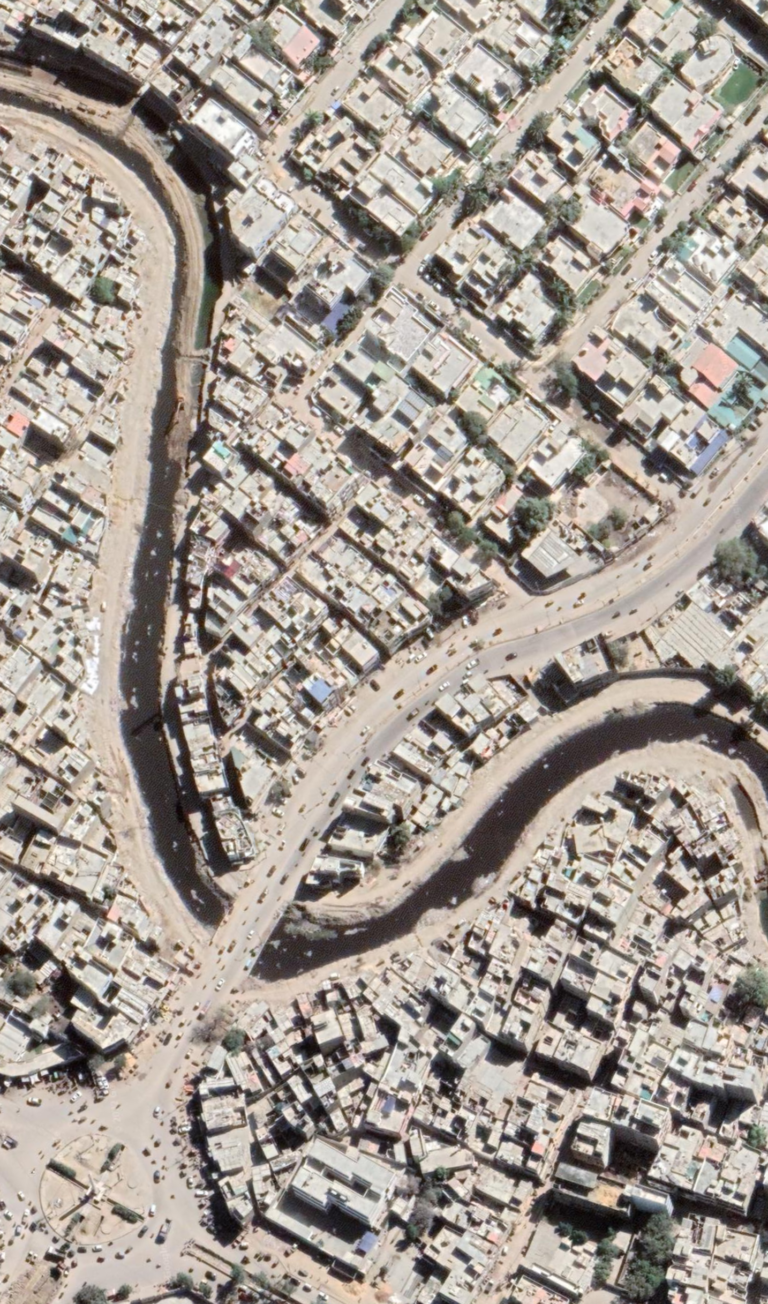
The demolitions along Gujjar nullah are part of the city authorities’ response to the climate crisis: they were carried out by the Karachi Metropolitan Corporation in response to a 2020 Supreme Court order, passed after record-breaking torrential rains lashed Karachi that summer. The order directed the National Disaster Management Authority in tandem with the government of the province of Sindh to remove “encroachments” along the waterway in an attempt to mitigate urban flooding.
But Yasmeen tells me that under the guise of monsoon preparedness or climate resilience, her neighborhood has been ravaged, lives have been uprooted, and nothing has remained the same.
As Karachi faces yet another spate of relentless rain this year, the—now extended—Gujjar nullah waterway has been overflowing. In fact, when it rains in Kausar Niazi Colony—despite the widening of the nullah—Yasmeen tells me it is like qayamat—the apocalypse. Water gushes into her home and her neighbor’s homes until it is waist-deep, bringing with it a plethora of diseases, malaise, and mosquitoes that keep her children and grandchildren up at night.
There have also been fatalities. “If you stand here,” Yasmeen said, gesturing towards the narrow, unpaved walkway separating the remnants of her home and the nullah, “and if you trip by accident, you will fall towards your death.” Earlier this summer, on July 13, 65-year-old Boota Masih was sitting outside his home—about a quarter of which was demolished last year—when he slipped and fell into the waterway below. And even though his community rallied, organized a search-and-rescue operation almost immediately, and tried to shift him to the hospital nearby as soon as possible, Masih did not survive.
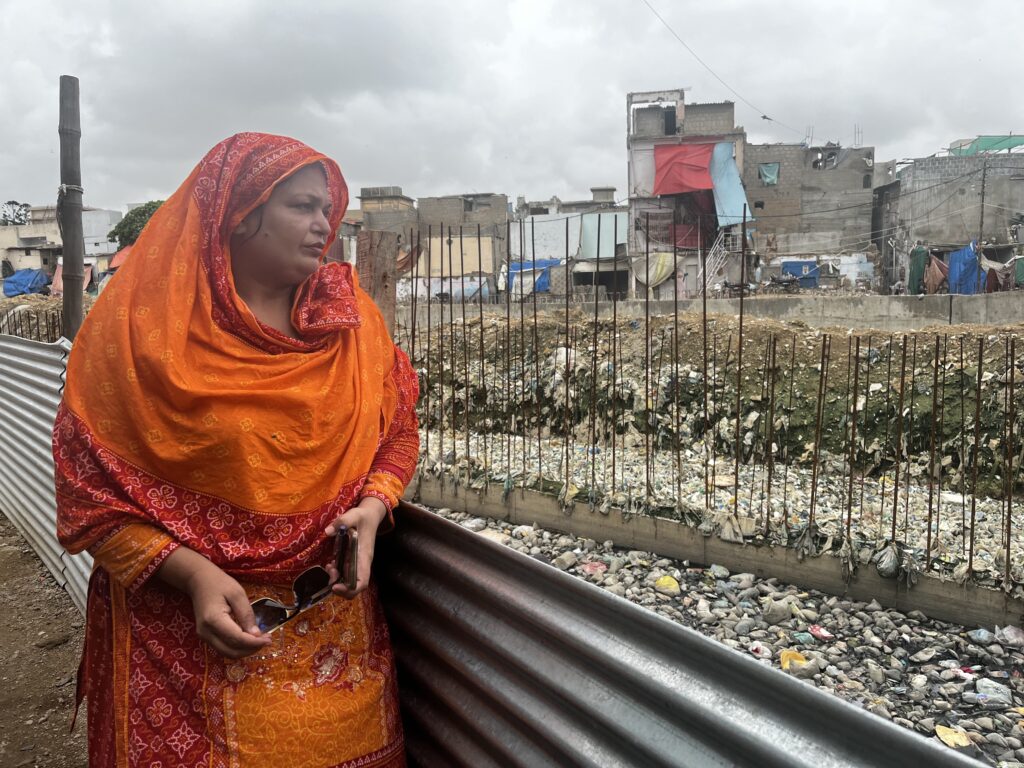
Removing “encroachments” or demolishing homes?
In the face of concretized development—and planning that worsens the city’s already fragile infrastructure—the Karachi Bachao Tehreek, a movement of demolition-affected city residents, is fighting back. In December 2021, the Tehreek published a survey comprising of 354 responses collected from residents living along the nullah and discovered that at least 45 percent of homes were constructed on leased and/or regularized properties, subsequently refuting the notion that residents living along the nullah were encroachers.
Now, Gujjar nullah residents whose homes were razed down say they have been denied the 90,000 Pakistani rupees (408 Euro) promised by the government as compensation, and that municipal bodies responsible for issuing cheques—such the Karachi Metropolitan Corporation—have been giving them the runaround.
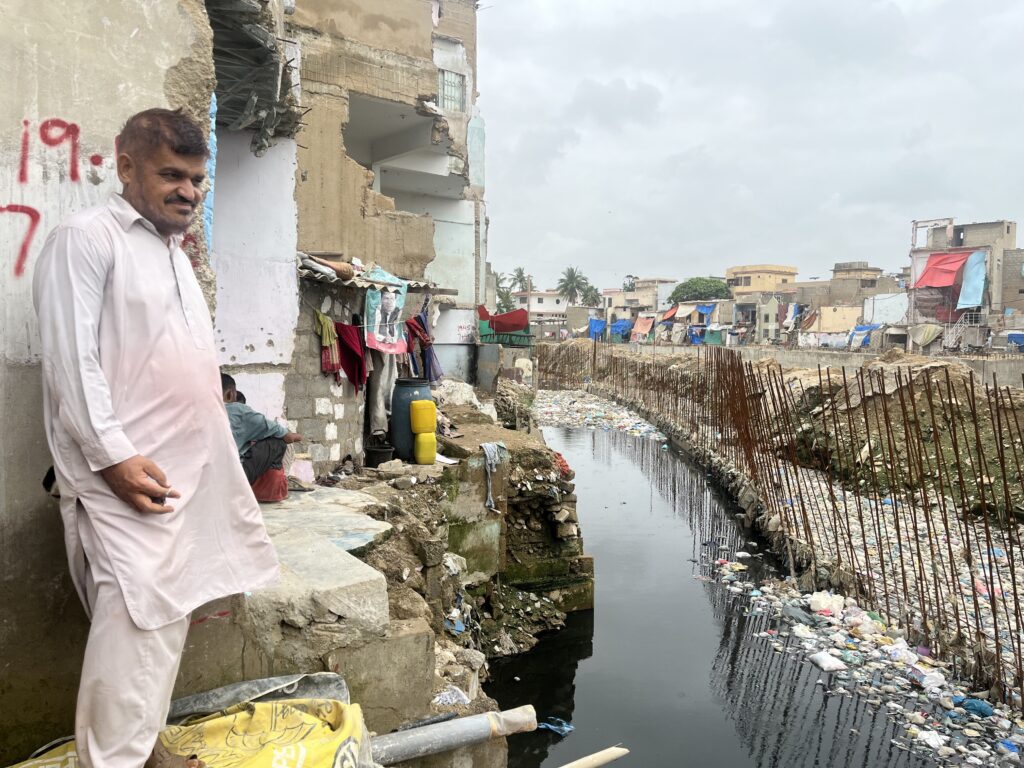
In late November 2021, the Sindh Environment Protection Agency published an obscure announcement in a local newspaper stating that a public hearing was scheduled to take place on the 30th of the month, at 10 am. The subject of the hearing was an Environmental Impact Assessment report of a proposed project revamping and restoring the city’s stormwater drains. Except: the report stated that no project shall commence until the assessment has been accomplished—and this hearing was taking place 14 months after demolitions along the Gujjar nullah began, and at least 12,000 homes had already been razed down.
“These are your words,” Aadil Ayub, an activist associated with the Karachi Bachao Tehreek, told a handful of Agency officials at the hearing. The National Disaster Management Authority—the proponent of the project—was conveniently absent. “Hundreds have been displaced. What is the point now, of this assessment? An EIA preemptively measures risk.”
The Sindh Environment Protection Agency’s response was sheepish at best. The city was in the throes of an emergency—Covid-19, climate change, floods—and the federal government had pumped in money to “transform” the city. Consequently, the Agency thought it was prudent to forge ahead with the project and hold the hearing retroactively, months later.
A month later, in December 2021, the Karachi Bachao Tehreek organized a People’s Climate March to draw attention towards the climate crisis brewing in the province and the city—the chopping up of mangroves near coastal belts to build industrial zones and posh huts for the city’s elite, and the construction of expressways over stormwater drains. But the march was violently suppressed and prevented from marching to Bilawal House—home of the chairman of the ruling party of Sindh, Bilawal Bhutto—by heavy contingents of police who blockaded and surrounded protestors on all sides.
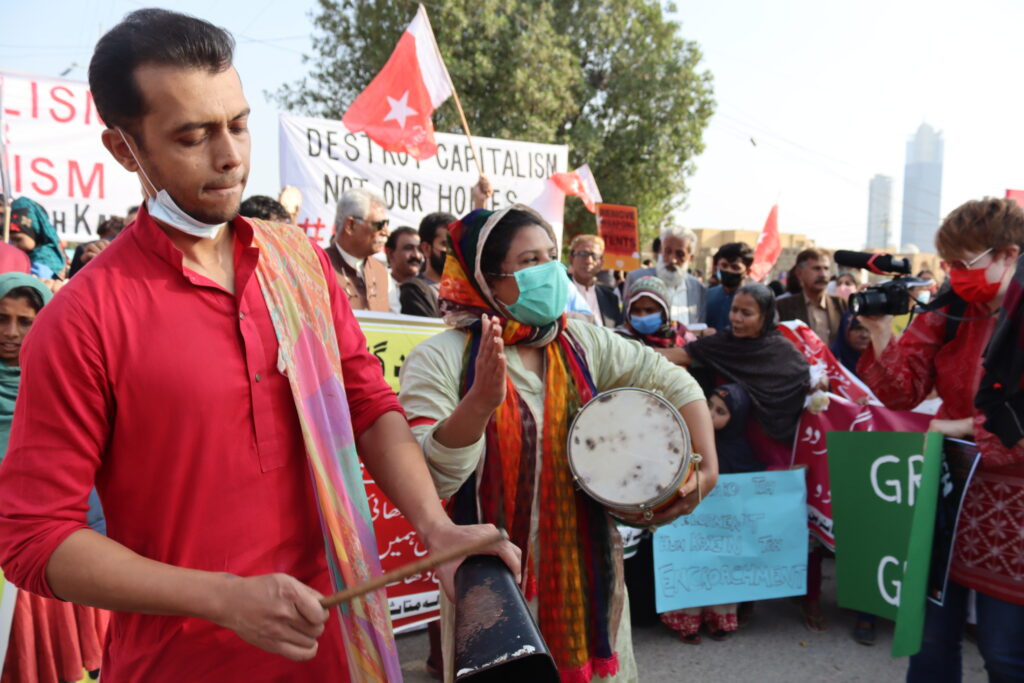
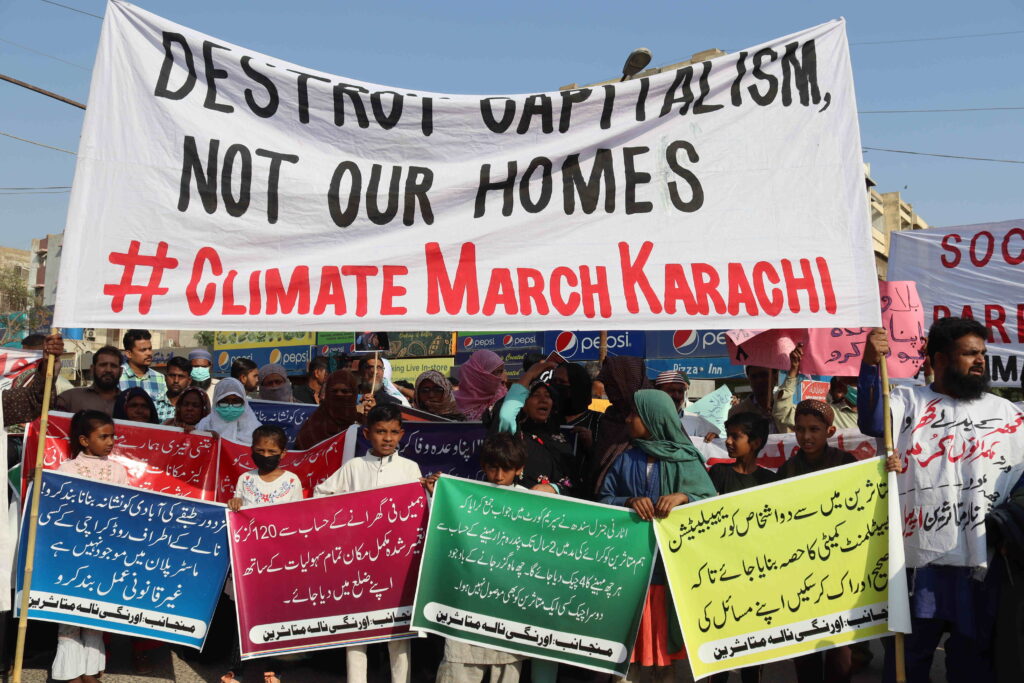
This wasn’t the first time that members of the Tehreek were subjected to violence and police brutality. Just six months prior, in June 2021, at least 20 Tehreek activists and Gujjar nullah residents—including Erum Yasmeen—were arrested outside Bilawal House where they were protesting against the demolition of homes being carried out on the Supreme Court’s orders.
Now, physicist-turned-climate activist Ahmad Shabbar believes that the only way to spur the government into action—and subsequently hold them accountable for their inaction in the face of a brewing climate catastrophe, or, in the case of the Gujjar nullah demolitions, their absence of foresight and planning—is by dragging them to court.
Taking the city to court
In September 2021, Shabbar and his lawyer, Jibran Nasir, took the government to court for proposing to build a city on two islands—covered in a thatch of mangrove forests—off the coast of Karachi. And in February this year, Shabbar and Nasir won. Now, as the Sindh Environment Protection Agency—the government body that organized the November 2021 hearing—builds an expressway by cutting up the Malir riverbed, one of the last remaining green belts in the city, Shabbar and a group of activists have taken the Agency to court once more.
“We have arrived at a point where there is nothing else we can do, except take them to court,” Shabbar said. “The reason why this is the case is because the government does not believe in dialogue.” The Sindh Environment Protection Agency did not respond to several requests for comment.
Time is also running out, fast. New research indicates that the city is sinking faster than sea level is rising. According to a study published in Geophysical Research Letters in March this year, in Karachi, the land is sinking nearly five times as fast as sea level is rising.
In another recently published study, researcher and spatial data scientist Shamsa Kanwal has found that rapid urbanization, construction on reclaimed land along the coastline, and sewerage network breakage have all contributed to subsidence—sinking of the ground because of underground material movement—in Karachi. “It’s as simple as a drainpipe collapsing, and over time, the ground around it will begin to subside,” she told me over the phone from Germany. “It also doesn’t help that the Sindh [province] coast is a low-lying coast—it is already at the level with the Arabian sea. What that means is, in Karachi, you are already living at sea-level, and when sea-level rises even slightly, people living in the city are automatically at risk.”
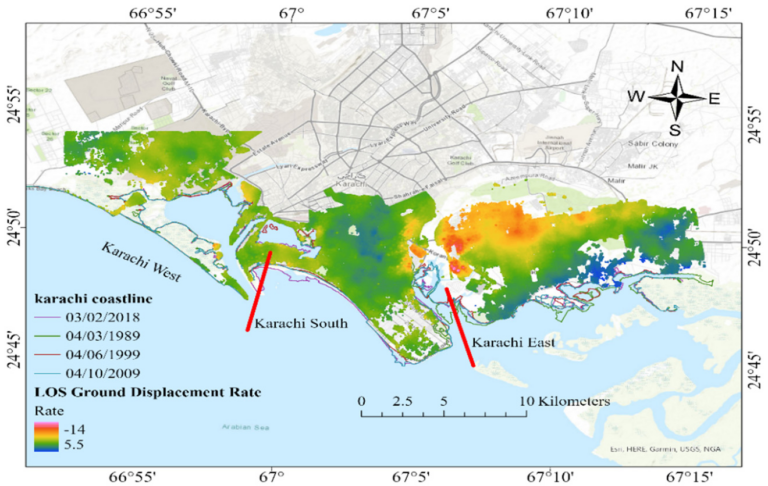
But the absence of data is hindering Kanwal’s work. Her attempts to investigate city-wide correlations between subsidence and groundwater depletion have been thwarted by Karachi’s abysmal water supply infrastructure, exacerbated by the city’s rapid expansion and unauthorized hydrants. “Karachi has multiple sources of water supply and there are no consolidated statistics, and there is no long-term data, and no numerical evidence,” she said.
There are areas she has managed to study, though, and her research reveals shocking results. Near the University of Karachi, Kanwal discovered a house that had sunk six feet below its initial foundation level. “[Discovering that house] was huge. You could see cracks in the walls, you could see that the elevation of the house was lower than all the other houses in the area,” she said.
“There’s so much happening in tandem in Karachi—sea level is rising, there is coastal erosion, subsidence, there’s also the broken sewage network, groundwater is depleting. It is really complicated and requires immediate attention.”
Shamsa Kanwal, researcher and spatial data scientist
After the August 2020 rains, residents of Karachi’s posh—and military-operated—Defence Housing Authority took to the streets after their million-dollar properties were submerged under several feet of rainwater. Bereft of electricity and internet for nearly five days, a motley crew of about 100-or-so protestors—middle-aged men wearing baseball hats and designer sunglasses, a handful of activists, women and children wielding hand-drawn posters, and a celebrity or two—clamored outside a municipal office responsible for the DHA’s upkeep and drainage on a Monday afternoon. For many, this was their first protest. This was also the first time—in recent memory—that the city’s elite erupted onto the streets protesting the absence of basic services.
Great respect to these wonderful citizens who have gathered for a peaceful protest against CBC & DHA authorities. Senior citizens, men, women & even children. Incompetence can NO longer be accepted. #Karachi #KarachiRain #DHAKARACHI pic.twitter.com/2NRQT4q1Kp
— Fakhr-e-Alam (@falamb3) August 31, 2020
“But after Karachi floods, where does all the elite rage go?” Ayub, the climate-activist associated with the Karachi Bachao Tehreek asked when I spoke to him. “All the anger that comes from [wealthy] DHA residents, who form the base of our government, other political parties, is pacified and instrumentalized to manufacture consent for fascist, heartless demolition campaigns that have made the lives of thousands worse off.”
Indeed, the National Disaster Management Authority’s National Monsoon Contingency Plan’s sections on Karachi hinge solely on the “restoration of storm water drains”—with no mention of sea level rise, subsidence, or the swathes of million-dollar properties built along the city’s vulnerable coastline. “Execution work on Gujjar and Orangi Nullas is going on at [a] fast pace,” the plan states. “Once implemented, [it] will give well-needed respite to the populace of Karachi.” Erum Yasmeen — who is on the brink of homelessness — wonders whom the plan is for, and why the people of Gujjar nullah, lawful citizens of Karachi, have been relegated to the margins and left at the mercy of callous state institutions.
Karachi's new saints
While 8000 homes were razed down along the Gujjar nullah, construction by the coast for the city’s elite continues unabated—despite a court order from October 2021 barring the Defence Housing Authority from reclaiming and selling coastal properties. And Emaar Pakistan, a luxury waterfront project along the coastline located in Defence Housing Authority’s (reclaimed) Phase 8— where a three-bedroom apartment costs PKR 44 million (0.2 million Euro)—has allegedly been constructed without environment impact assessment. Inside the gated complex, there are swanky restaurants, private beaches for residents, and no prospects of anti-encroachment demolitions.
“Encroachment is class divided. If a rich person is encroaching on land that is considered valuable real estate, do we acknowledge it as encroachment?” said architect Marvi Mazhar.
“On the flip side, encroachment [in low-income localities] is often a consequence of government neglect and corruption over the years, up until suddenly, they realize that Gujjar nullah is really important because they want to build a road over it to Bahria Town or DHA City (gated communities near Karachi’s outskirts).”
Bahria Town Karachi, a gated housing scheme owned by real estate tycoon Malik Riaz, has come under scrutiny—from both civil society and activists, as well as local journalists—for its alleged occupation of indigenous lands near Karachi’s outskirts. But attempts to hold the project accountable have largely been in vain. In 2018, Pakistan’s Supreme Court issued a verdict preventing the project from undertaking any development beyond 6000 acres. Just a year later, in 2019, the Court went back on their words: Riaz, the real estate tycoon, was asked to dole out 460 billion Pakistani rupees (about 1.9 billion Euro) after which the Court legalized the housing project’s occupation of 16,896 acres of land. Now, properties in the gated housing development continue to sell like hot cakes, with 500 square yard plots—overlooking a privately-owned golf course—costing up to 15 million Pakistani rupees (about 64,000 Euro).
About 60 kilometers from Bahria Town, the shrine of Karachi’s patron saint, Abdullah Shah Ghazi, has been shrouded by none other than Malik Riaz himself. According to local legend, Ghazi’s shrine, from its perch above the Arabian sea, protected the city over the years—from cyclones, tsunamis, and the sea’s rage. Before Riaz built an 1.89 billion rupee underpass and flyover project, and the 70-story multi rise Bahria Icon Tower, smack before the shrine’s gates, one could see a sea of devotees—men, women and children cutting through throngs of merchants selling rose petals and devotional banners to lay atop Ghazi’s tomb—climbing up the shrine’s narrow flight of stairs.
Now, all that can be seen—for miles and miles—is Riaz’s new multi-million rupee corporatized facade encircled with a massive boundary wall that blocks a clear view of the shrine from the surroundings, as was the case once before. The green dome has been replaced with beige concrete, eclectic tiles replaced with generic stone cladding, and the itinerant occupying the shrine’s compound cast out. What was once a vibrant place space, wrote art historian Kishwar Rizvi in a paper published in 2020, has now been reduced to a branding opportunity, bringing great wealth to contractors and real estate investors, while displacing local history and rituals.
Mazhar, the architect, believes new saints have usurped the old in Karachi. “The real estate developers that are swallowing and concretizing our coastline—they have become the new saints of the city,” she said.
In 2022, Mazhar was appointed Amicus Curiae by the Sindh High Court in a case against the Defence Housing Authority’s development and land reclamation along Karachi’s coastline. In the court, she says, there is a “huge chuckle” when defendants are asked who was responsible for reclaiming the land. “Who made the land? No one knows. Once the land was made, who did the master planning? No one knows. Now, as the city floods year after year, it is because of the choices, or lack thereof, that developers [like the DHA] have made, and ordinary people continue to suffer.”


